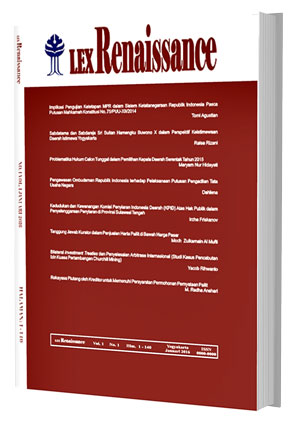Main Article Content
Abstract
Keywords
Article Details
Authors who publish with this journal agree to the following terms:
a. Authors retain copyright and grant the journal right of first publication with the work simultaneously licensed under a Creative Commons Attribution License that allows others to share the work with an acknowledgement of the work's authorship and initial publication in this journal.
b. Authors are able to enter into separate, additional contractual arrangements for the non-exclusive distribution of the journal's published version of the work (e.g., post it to an institutional repository or publish it in a book), with an acknowledgement of its initial publication in this journal.
c. Authors are permitted and encouraged to post their work online (e.g., in institutional repositories or on their website) prior to and during the submission process, as it can lead to productive exchanges, as well as earlier and greater citation of published work (See The Effect of Open Access).References
- Buku
- Achmad, Yulianto dan Mukti Fajar, Dualisme Penelitian Hukum Normatif & Empiris, Pustaka Pelajar, Yogyakarta, 2010.
- Kusuma, Mulyana W, Hukum dan Hak-Hak Anak, CV. Rajawali, Jakarta, 1986.
- Marlina, Pengantar Konsep Diversi dan Restorative Justice, USU Press, Medan, 2010.
- _______, Peradilan Pidana Anak di Indonesia (Pengembangan Konsep Diversi), Refika Aditama, Bandung, 2012.
- Marzuki, Peter Mahmud, Penelitian Hukum Edisi Revisi, Prenadamedia Group, Jakarta, 2016.
- Prodjodikoro, Wirjono, Asas-Asas Hukum Pidana Indonesia. PT. Eresco, Bandung, 1989.
- Sambas, Nandang, Pemberharuan Sistem Pemidanaan Anak di Indonesia, Graha Ilmu, Yogyakarta, 2010.
- Soekanto, Soerjono dan Sri Mamudji, Penelitian Hukum Normatif, Rajawali, Jakarta, 1985.
- Jurnal
- Yati Sharfina Desiandri, “Diversi Terhadap Anak yang Berkonflik dengan Hukum di Tingkat Penyidikan”, USU Law Journal, Vol. 5 No. 1, Januari 2017.
- Website
- http://www.hukumonline.com/berita/baca/lt5475dd3e4d788/icjr, Aparat Hukum Belum Paham Arti Diversi. Diakses pada tanggal 28 Maret 2017 pukul 10.26
- http://www.hukumonline.com/berita/baca/lt4e25360a422c2 Jecky Tengens, SH, Pendekatan Restorative Justice dalam Sistem Pidana Indonesia. Diakses pada tanggal 25 Oktober 2017 pukul 11.56
- Peraturan Perundang-undangan
- Kitab Undang-Undang Hukum Acara Pidana (KUHAP)
- Kitab Undang-Undang Hukum Pidana (KUHP)
- Undang-Undang Nomor 1 Tahun 1946 tentang Peraturan Hukum Pidana
- Undang-Undang Nomor 8 Tahun 1996 tentang Pengesahan Convention On Psychotropic Substance 1971 (Konvensi Psikotropika 1971)
- Undang-Undang Nomor 35 Tahun 2009 tentang Narkotika
- Undang-Undang No. 11 Tahun 2012 tentang Sistem Peradilan Pidana Anak
- Peraturan Mahkamah Agung Nomor 4 Tahun 2014 tentang Pedoman Pelaksaan Diversi dalam Sistem Peradilan Pidana Anak
- Putusan Pengadilan
- PUTUSAN NOMOR : 6/PID.Sus.Anak/2015/PT.MDN.
- PUTUSAN NOMOR : 28/Pid.Sus-Anak/2017/PN Smn.
References
Buku
Achmad, Yulianto dan Mukti Fajar, Dualisme Penelitian Hukum Normatif & Empiris, Pustaka Pelajar, Yogyakarta, 2010.
Kusuma, Mulyana W, Hukum dan Hak-Hak Anak, CV. Rajawali, Jakarta, 1986.
Marlina, Pengantar Konsep Diversi dan Restorative Justice, USU Press, Medan, 2010.
_______, Peradilan Pidana Anak di Indonesia (Pengembangan Konsep Diversi), Refika Aditama, Bandung, 2012.
Marzuki, Peter Mahmud, Penelitian Hukum Edisi Revisi, Prenadamedia Group, Jakarta, 2016.
Prodjodikoro, Wirjono, Asas-Asas Hukum Pidana Indonesia. PT. Eresco, Bandung, 1989.
Sambas, Nandang, Pemberharuan Sistem Pemidanaan Anak di Indonesia, Graha Ilmu, Yogyakarta, 2010.
Soekanto, Soerjono dan Sri Mamudji, Penelitian Hukum Normatif, Rajawali, Jakarta, 1985.
Jurnal
Yati Sharfina Desiandri, “Diversi Terhadap Anak yang Berkonflik dengan Hukum di Tingkat Penyidikan”, USU Law Journal, Vol. 5 No. 1, Januari 2017.
Website
http://www.hukumonline.com/berita/baca/lt5475dd3e4d788/icjr, Aparat Hukum Belum Paham Arti Diversi. Diakses pada tanggal 28 Maret 2017 pukul 10.26
http://www.hukumonline.com/berita/baca/lt4e25360a422c2 Jecky Tengens, SH, Pendekatan Restorative Justice dalam Sistem Pidana Indonesia. Diakses pada tanggal 25 Oktober 2017 pukul 11.56
Peraturan Perundang-undangan
Kitab Undang-Undang Hukum Acara Pidana (KUHAP)
Kitab Undang-Undang Hukum Pidana (KUHP)
Undang-Undang Nomor 1 Tahun 1946 tentang Peraturan Hukum Pidana
Undang-Undang Nomor 8 Tahun 1996 tentang Pengesahan Convention On Psychotropic Substance 1971 (Konvensi Psikotropika 1971)
Undang-Undang Nomor 35 Tahun 2009 tentang Narkotika
Undang-Undang No. 11 Tahun 2012 tentang Sistem Peradilan Pidana Anak
Peraturan Mahkamah Agung Nomor 4 Tahun 2014 tentang Pedoman Pelaksaan Diversi dalam Sistem Peradilan Pidana Anak
Putusan Pengadilan
PUTUSAN NOMOR : 6/PID.Sus.Anak/2015/PT.MDN.
PUTUSAN NOMOR : 28/Pid.Sus-Anak/2017/PN Smn.




